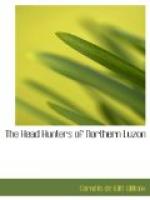Individuals appeared to be friendly enough, though these were chiefly the older men. One of them, a total stranger to me, came up and intimated very clearly that he would like the transfer of the cigar I was smoking from my lips to his. In a case like this, it is certainly more blessed to give than to receive, but in spite of this Scriptural view of the matter, I nevertheless naturally hesitated to be the party of even the second part in a liberty of such magnitude, and on such short acquaintance, too. However I gave him the cigar; he received it with graciousness. I found now that I must give cigars to all the rest standing about, and, after emptying my pockets, sent for two boxes. An expectant crowd had in the meantime collected below, for we were standing on the upper veranda of Government House, and, on the two hundred cigars being thrown out to them all at one time, came together at the point of fall in the mightiest rush and crush of human beings I ever saw in my life. A foot-ball scrimmage under the old rules was nothing to it. Very few cigars came out unscathed, but the scramble was perfectly good-humored.
Of weapons there was almost none visible, no shields or spears, but here and there a head-ax. The usual fashion in clothes prevailed; gee-string for the men, and short sarong-like skirt for the women. Hair was worn long, many men gathering it up into a tiny brimless hat, for all the world like Tommy Atkins’s pill-box, only worn squarely on the apex of the skull, and held on by a string passed through the hair in front. In this hat the pipe and tobacco are frequently carried. Many of these hats are beautifully made, and decorated; straw, dyed of various colors, being combined in geometrical patterns. Ordinary ones can be easily got; but, if ornamented with beads or shell, they command very high prices, one hundred and fifty pesos or more. Many men were elaborately tattooed, the pattern starting well down the chest on each side and running up around the front of the shoulder and part way down the arm. If, as is said, this elaborate tattoo indicates that its owner has killed a human being, then Bontok during our stay was full of men that had proved their valor in this particular way. Earrings were very common in both sexes; frequently the lobe was distended by a plug of wood, with no appreciable effect of ornament, and sometimes even torn open. In that case the earring would be held on by a string over the ear. One man came by with three earrings in the upper cartilage of each ear, one above the other. Still another had actually succeeded in persuading nature to form a socket of gristle just in front of each ear, the socket being in relief and carrying a bunch of feathers. A few men had even painted their faces scarlet or yellow. No one seemed to know the significance of this habit (commoner farther north than at Bontok), but the paint was put on much after the fashion prevailing in Manchuria, and, if possibly for the same reason, certainly with the same result. The pigment or color comes from a wild berry.




